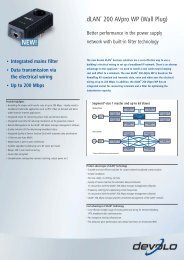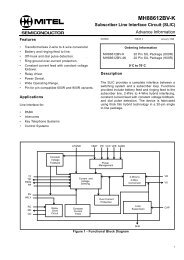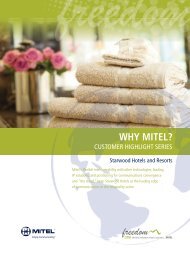Mitel Technical Specification 22
Mitel Technical Specification 22
Mitel Technical Specification 22
Create successful ePaper yourself
Turn your PDF publications into a flip-book with our unique Google optimized e-Paper software.
MiNET <strong>Specification</strong><br />
5.2.1.1.5Circle Rate / Square Rate (CRSR)<br />
The CRSR octet is defined as follows:<br />
Bits 8 to 5 = Circle Rate<br />
Bits 4 to 1 = Square Rate<br />
The values listed below (decimal) are defined for circle and square rates:<br />
0 = OFF solid<br />
1 = ON solid<br />
2 = rate 2 (250 ms OFF, 250 ms ON)<br />
3 = rate 3 (500 ms OFF, 500 ms ON)<br />
4 = rate 4 (438 ms OFF, 62 ms ON)<br />
5 = rate 5 (62 ms OFF, 438 ms ON)<br />
6 to 13 = pre-definable rates<br />
14 = rate 14 (125 ms OFF, 125 ms ON)<br />
15 = not valid for circle, but for square means square flashes at inverse of circle<br />
5.2.1.1.6Circle / Square Rate Number (CSRN)<br />
The CSRN octet is defined as follows (values are shown in decimal):<br />
Bits 8 to 5 = unused<br />
Bits 4 to 1 = Rate Number<br />
Values 0 to 5, 14, 15 = reserved<br />
Values 6 to 13 = rates 6 to 13<br />
5.2.1.1.7Hardware Control Byte (HCB)<br />
Two HCB octets, HCB0 and HCB1, are defined as shown below.<br />
The defined hardware functions, when set to 1 in bits 6 to 1, shall be turned ON or OFF depending on the<br />
state of bit 8.<br />
The format of the HCB0 octet is as follows:<br />
b8 b7 b6 b5 b4 b3 b2 b1<br />
ON/OFF 0 HS HFS HFMF DG NC RNG<br />
HS = handset microphone (see note 1)<br />
HFS = handsfree speaker<br />
HFMF = handsfree microphone function (see note 2)<br />
DG = DTMF generator (see note 3)<br />
NC = noise cancellation during handsfree operation<br />
RNG = ringer<br />
Note 1- The purpose of the HS bit is to control the handset microphone, earpiece and sidetone together.<br />
Note 2- The purpose of the HFMF bit is to control both the handsfree microphone and the handsfree<br />
algorithm.<br />
Note 3- When the DG bit is enabled, the DTMF generator sends tones to all active local transducers and to<br />
the line as PCM. Disabling the DTMF generator shall not affect a key depression already in<br />
progress (i.e. shall only affect the next key depression).<br />
The format of the HCB1 octet is as follows:<br />
b8 b7 b6 b5 b4 b3 b2 b1<br />
ON/OFF1 0 HFM LIND HSNV SIDE EA<br />
HFM = handsfree microphone (see note 1)<br />
LIND = line DTMF (see note 2)<br />
HSNV = handset nominal volume (see note 3)<br />
SIDE = sidetone<br />
EAR = earpiece<br />
Note 1- The purpose of the HFM bit is to control the handsfree microphone only and therefore is different<br />
from the HFMF bit in HCB0. The latter bit controls both the handsfree microphone and the<br />
handsfree algorithm at the same time.<br />
<strong>Mitel</strong> Restricted MTS<strong>22</strong> (Version B05) 3:12 PM 30/12/10Page 42 of 173





